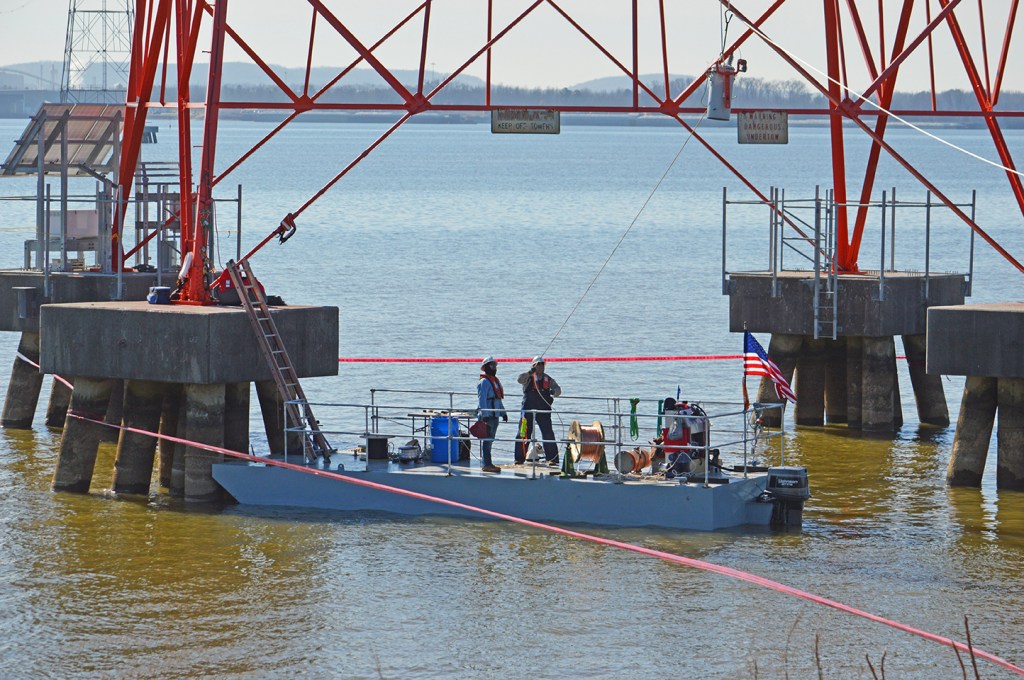TVA transmission towers getting new lights
Published 6:15 am Friday, January 26, 2018

- Workers with SBC Construction remove a transformer from a TVA tower in the Tennessee River on Thursday morning. The transformer was attached to a wire and guided down the tower before it was gathered in by the men on the boat.
The transmission towers near Browns Ferry Nuclear Plant, just outside of Athens, are getting a facelift, thanks to a collaborative effort between the Tennessee Valley Authority, SBC Construction and Mesa Engineering.
The project consists of removing the electrical lights currently on the four towers and replacing them with LED lights that are solar-powered.
Trending
“We’ve had maintenance issues with the lights due to lightning over time,” TVA project manager John Pickering said. “Previously, the lights were powered by local power companies, and their power feeds were fine. The problem we ran into was when lightning would strike the overhead ground wire, which was carrying the power on the previous system, which created maintenance problems.
“This new system will solve a lot of those maintenance problems and provide a more reliable system for areas that are hard to get to.”
But replacing these light bulbs isn’t as easy as unscrewing one light bulb and screwing in another. First of all, the towers are more than 300 feet tall. Secondly, they’re located in the Tennessee River.
“This is about a three- to four-month process,” Pickering said. “The first step is removing the previous system we used to power the lights, removing those lights and removing portions of the power feeds to them. The second step is essentially installing the solar systems on the base of each tower on two of the legs, and running lines up to the lights and connecting those lines up.”
The lights are required on the tower by the Federal Aviation Administration, as any tower taller than 200 feet is required to have aviation lighting.
“We’ve got to make sure all the aviators out there are safe,” Pickering said. “The towers are brightly painted to make them more visible in the daytime, and the lights are for the nighttime.”
Trending
TVA said solar-powered LED lights were chosen because they provide an onsite power source which is more cost effective, increases reliability and improves safety.
Each solar panel generates about 320 watts, which is about the same amount of power it would take to charge 86 smartphones.
Seven towers have been fitted with solar lighting with more planned for the future. Each tower is individually fitted. On the project replacing lights on the four towers in the river, the two south-facing legs of the tower are fitted with solar lighting components, Pickering said.
The solar panels are fixed and oriented to the south so they will receive the most sun. There are five small solar panels powering a set of three lights on each tower. There are eight deep-cycle backup batteries used to store power, he said.
Pickering said the new lighting will also have small windmills. While these are tied into the battery backup for the solar panels, they provide a small amount of wattage assistance are primarily a design improvement to prevent birds from nesting near the solar panels.
Pickering said another important part of the project is the monitoring systems attached to the lights, which will let TVA know if there is any malfunction in the lights.
“There is an FAA requirement for TVA to know the status of the lights, so there is a monitoring system on each one of these lights, and that is fed through a cell phone signal to a TVA facility,” he said. “If there’s maintenance issues with the lights, we’ll know about it and can send maintenance crews out to deal with it.”
Pickering praised the partnership between TVA and the two companies it is working with on the project.
“This really is a collaborative effort,” he said. “SBC is the construction company out here today doing the work and Mesa Engineering is the company that worked with us to actually do the design. We have worked well with both of them to get this project going.”





